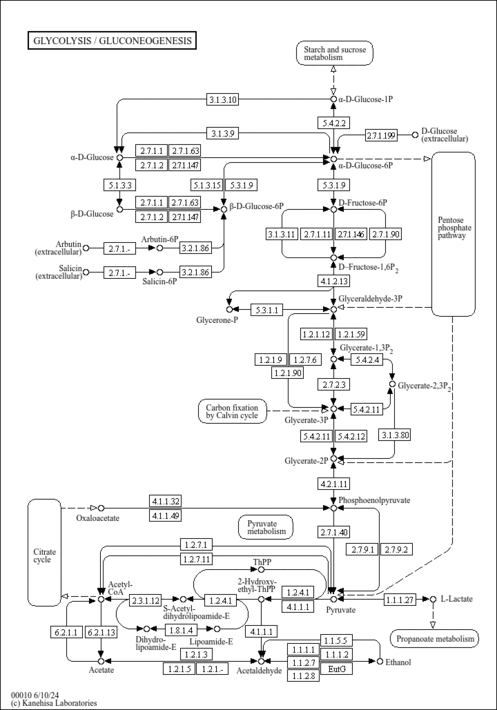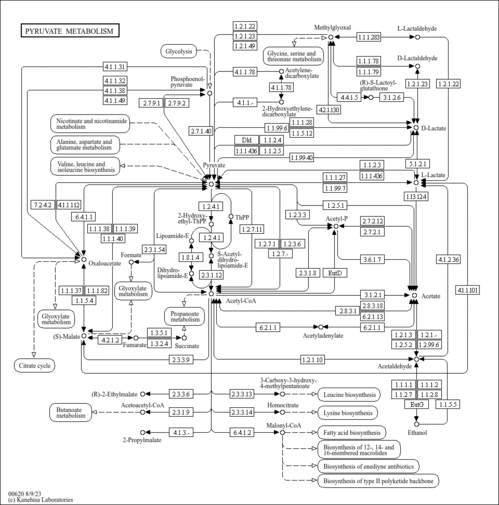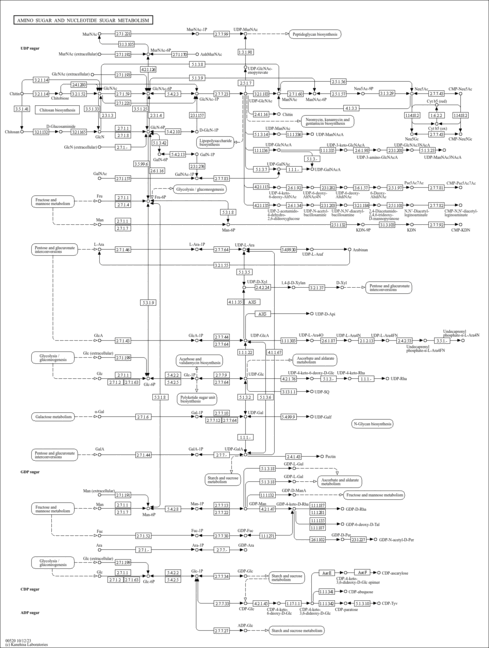| Record Information |
|---|
| Version | 1.0 |
|---|
| Created at | 2020-04-17 19:08:13 UTC |
|---|
| Updated at | 2020-11-18 16:39:19 UTC |
|---|
| CannabisDB ID | CDB005089 |
|---|
| Secondary Accession Numbers | Not Available |
|---|
| Cannabis Compound Identification |
|---|
| Common Name | Phosphoenolpyruvic acid |
|---|
| Description | Phosphoenolpyruvic acid, also known as PEP or 2-phosphonooxyprop-2-enoate, belongs to the class of organic compounds known as phosphate esters. These are organic compounds containing phosphoric acid ester functional group, with the general structure R1P(=O)(R2)OR3. R1,R2 = O,N, or halogen atom; R3 = organyl group. Phosphoenolpyruvic acid is an extremely strong acidic compound (based on its pKa). Phosphoenolpyruvic acid exists in all living species, ranging from bacteria to humans. Outside of the human body, Phosphoenolpyruvic acid has been detected, but not quantified in, several different foods, such as pepper (c. frutescens), grapes, mexican groundcherries, black raspberries, and wasabis. This could make phosphoenolpyruvic acid a potential biomarker for the consumption of these foods. Phosphoenolpyruvic acid is expected to be in Cannabis as all living plants are known to produce and metabolize it. |
|---|
| Structure | |
|---|
| Synonyms | | Value | Source |
|---|
| 2-(Phosphonooxy)-2-propenoic acid | ChEBI | | 2-PHOSPHOENOLPYRUVIC ACID | ChEBI | | PEP | ChEBI | | PHOSPHOENOLPYRUVATE | ChEBI | | 2-(Phosphonooxy)-2-propenoate | Generator | | 2-PHOSPHOENOLPYRUVate | Generator | | 2-Hydroxy-acrylic acid dihydrogen phosphate | HMDB | | 2-Phosphonooxyprop-2-enoate | HMDB | | 2-Phosphonooxyprop-2-enoic acid | HMDB | | p-enol-Pyruvate | HMDB | | PEP (phosphate) | HMDB | | Phosphoenolpyruvic acid | HMDB |
|
|---|
| Chemical Formula | C3H5O6P |
|---|
| Average Molecular Weight | 168.04 |
|---|
| Monoisotopic Molecular Weight | 167.9824 |
|---|
| IUPAC Name | 2-(phosphonooxy)prop-2-enoic acid |
|---|
| Traditional Name | phosphoenolpyruvic acid |
|---|
| CAS Registry Number | 138-08-9 |
|---|
| SMILES | OC(=O)C(=C)OP(O)(O)=O |
|---|
| InChI Identifier | InChI=1S/C3H5O6P/c1-2(3(4)5)9-10(6,7)8/h1H2,(H,4,5)(H2,6,7,8) |
|---|
| InChI Key | DTBNBXWJWCWCIK-UHFFFAOYSA-N |
|---|
| Chemical Taxonomy |
|---|
| Description | Belongs to the class of organic compounds known as phosphate esters. These are organic compounds containing phosphoric acid ester functional group, with the general structure R1P(=O)(R2)OR3. R1,R2 = O,N, or halogen atom; R3 = organyl group. |
|---|
| Kingdom | Organic compounds |
|---|
| Super Class | Organic acids and derivatives |
|---|
| Class | Organic phosphoric acids and derivatives |
|---|
| Sub Class | Phosphate esters |
|---|
| Direct Parent | Phosphate esters |
|---|
| Alternative Parents | |
|---|
| Substituents | - Phosphoric acid ester
- Monocarboxylic acid or derivatives
- Carboxylic acid
- Carboxylic acid derivative
- Organic oxygen compound
- Organic oxide
- Hydrocarbon derivative
- Organooxygen compound
- Carbonyl group
- Aliphatic acyclic compound
|
|---|
| Molecular Framework | Aliphatic acyclic compounds |
|---|
| External Descriptors | |
|---|
| Ontology |
|---|
|
| Disposition | Route of exposure: Source: Biological location: |
|---|
| Role | Industrial application: |
|---|
| Physical Properties |
|---|
| State | Solid |
|---|
| Experimental Properties | | Property | Value | Reference |
|---|
| Melting Point | Not Available | Not Available | | Boiling Point | Not Available | Not Available | | Water Solubility | Not Available | Not Available | | logP | Not Available | Not Available |
|
|---|
| Predicted Properties | [] |
|---|
| Spectra |
|---|
| EI-MS/GC-MS | | Type | Description | Splash Key | View |
|---|
| GC-MS | Phosphoenolpyruvic acid, non-derivatized, GC-MS Spectrum | splash10-0292-0962000000-44d3914b4e07e5c50e3f | Spectrum | | GC-MS | Phosphoenolpyruvic acid, non-derivatized, GC-MS Spectrum | splash10-0292-0962000000-44d3914b4e07e5c50e3f | Spectrum | | Predicted GC-MS | Phosphoenolpyruvic acid, non-derivatized, Predicted GC-MS Spectrum - 70eV, Positive | splash10-0002-9200000000-ae9d81fc88a98f678268 | Spectrum | | Predicted GC-MS | Phosphoenolpyruvic acid, 1 TMS, Predicted GC-MS Spectrum - 70eV, Positive | splash10-00di-9410000000-072478606f0ab6809902 | Spectrum | | Predicted GC-MS | Phosphoenolpyruvic acid, non-derivatized, Predicted GC-MS Spectrum - 70eV, Positive | Not Available | Spectrum | | Predicted GC-MS | Phosphoenolpyruvic acid, TMS_1_2, Predicted GC-MS Spectrum - 70eV, Positive | Not Available | Spectrum | | Predicted GC-MS | Phosphoenolpyruvic acid, TBDMS_1_1, Predicted GC-MS Spectrum - 70eV, Positive | Not Available | Spectrum | | Predicted GC-MS | Phosphoenolpyruvic acid, TBDMS_1_2, Predicted GC-MS Spectrum - 70eV, Positive | Not Available | Spectrum |
|
|---|
| MS/MS | | Type | Description | Splash Key | View |
|---|
| MS/MS | LC-MS/MS Spectrum - Quattro_QQQ 10V, Positive (Annotated) | splash10-0udr-1900000000-9a4f5554af9a717d99c7 | 2012-07-24 | View Spectrum | | MS/MS | LC-MS/MS Spectrum - Quattro_QQQ 25V, Positive (Annotated) | splash10-000x-9200000000-6cdc15f3daa25fc41655 | 2012-07-24 | View Spectrum | | MS/MS | LC-MS/MS Spectrum - Quattro_QQQ 40V, Positive (Annotated) | splash10-001i-9100000000-39e22409d6d924a774f1 | 2012-07-24 | View Spectrum | | MS/MS | LC-MS/MS Spectrum - LC-ESI-ITFT (LTQ Orbitrap XL, Thermo Scientfic) , Positive | splash10-00xu-0912000000-ad1823470675975d5ff0 | 2012-08-31 | View Spectrum | | MS/MS | LC-MS/MS Spectrum - LC-ESI-ITFT (LTQ Orbitrap XL, Thermo Scientfic) , Positive | splash10-0udi-0900000000-1f5b761ce5fa374b0f8e | 2012-08-31 | View Spectrum | | MS/MS | LC-MS/MS Spectrum - LC-ESI-ITFT (LTQ Orbitrap XL, Thermo Scientfic) , Positive | splash10-000i-9000000000-d279f0ca2accb130181f | 2012-08-31 | View Spectrum | | MS/MS | LC-MS/MS Spectrum - LC-ESI-ITFT (LTQ Orbitrap XL, Thermo Scientfic) , Positive | splash10-0002-0920000000-f084dccf78e11c8760d7 | 2012-08-31 | View Spectrum | | MS/MS | LC-MS/MS Spectrum - LC-ESI-ITFT (LTQ Orbitrap XL, Thermo Scientfic) , Positive | splash10-00lr-0911000000-7fa833698210746c838f | 2012-08-31 | View Spectrum | | MS/MS | LC-MS/MS Spectrum - LC-ESI-ITFT (LTQ Orbitrap XL, Thermo Scientfic) , Positive | splash10-000i-9000000000-62e28301f20b08971b78 | 2012-08-31 | View Spectrum | | MS/MS | LC-MS/MS Spectrum - LC-ESI-ITFT (LTQ Orbitrap XL, Thermo Scientfic) , Positive | splash10-0udi-0900000000-25f970898112f7b89898 | 2012-08-31 | View Spectrum | | MS/MS | LC-MS/MS Spectrum - LC-ESI-ITFT (LTQ Orbitrap XL, Thermo Scientfic) , Positive | splash10-0002-0930000000-58691b23d317c2418c33 | 2012-08-31 | View Spectrum | | MS/MS | LC-MS/MS Spectrum - LC-ESI-ITFT (LTQ Orbitrap XL, Thermo Scientfic) , Negative | splash10-00p0-0493110000-9d61bb13ab5261fdf9fd | 2012-08-31 | View Spectrum | | MS/MS | LC-MS/MS Spectrum - LC-ESI-ITFT (LTQ Orbitrap XL, Thermo Scientfic) , Negative | splash10-004i-9100000000-db409b3cfa9ebabbcb58 | 2012-08-31 | View Spectrum | | MS/MS | LC-MS/MS Spectrum - LC-ESI-ITFT (LTQ Orbitrap XL, Thermo Scientfic) , Negative | splash10-0a4j-5090000000-1ee56bc4866301d4bf2e | 2012-08-31 | View Spectrum | | MS/MS | LC-MS/MS Spectrum - LC-ESI-ITFT (LTQ Orbitrap XL, Thermo Scientfic) , Negative | splash10-0a4i-0090000000-bce08b01d44391bfecad | 2012-08-31 | View Spectrum | | MS/MS | LC-MS/MS Spectrum - LC-ESI-QQ (API3000, Applied Biosystems) 10V, Negative | splash10-016r-7900000000-ffd3b8dcd65aaea26ac3 | 2012-08-31 | View Spectrum | | MS/MS | LC-MS/MS Spectrum - LC-ESI-QQ (API3000, Applied Biosystems) 20V, Negative | splash10-004i-9000000000-ceae3587b1e7d8b3da27 | 2012-08-31 | View Spectrum | | MS/MS | LC-MS/MS Spectrum - LC-ESI-QQ (API3000, Applied Biosystems) 30V, Negative | splash10-004i-9000000000-701a17330cd18255d625 | 2012-08-31 | View Spectrum | | MS/MS | LC-MS/MS Spectrum - LC-ESI-QQ (API3000, Applied Biosystems) 40V, Negative | splash10-004i-9000000000-a4178ce4951e2c3dba7b | 2012-08-31 | View Spectrum | | MS/MS | LC-MS/MS Spectrum - LC-ESI-QQ (API3000, Applied Biosystems) 50V, Negative | splash10-004i-9000000000-9d0421620a7aaa9ef33f | 2012-08-31 | View Spectrum | | MS/MS | LC-MS/MS Spectrum - LC-ESI-QQ (API3000, Applied Biosystems) 10V, Positive | splash10-0k9i-1900000000-fb12ade375a7ac97f150 | 2012-08-31 | View Spectrum | | MS/MS | LC-MS/MS Spectrum - LC-ESI-QQ (API3000, Applied Biosystems) 20V, Positive | splash10-0f76-8900000000-7f57e6a8e72e5992cd88 | 2012-08-31 | View Spectrum | | MS/MS | LC-MS/MS Spectrum - LC-ESI-QQ (API3000, Applied Biosystems) 30V, Positive | splash10-000j-9300000000-c02bca019150d572b3bc | 2012-08-31 | View Spectrum | | MS/MS | LC-MS/MS Spectrum - LC-ESI-QQ (API3000, Applied Biosystems) 40V, Positive | splash10-05bf-9200000000-73fa5ca52ecc17bac380 | 2012-08-31 | View Spectrum | | MS/MS | LC-MS/MS Spectrum - LC-ESI-QQ (API3000, Applied Biosystems) 50V, Positive | splash10-0079-9300000000-231346190165f44f28dc | 2012-08-31 | View Spectrum |
|
|---|
| NMR | | Type | Description | | View |
|---|
| 1D NMR | 1H NMR Spectrum (1D, 600 MHz, H2O, experimental) | | Spectrum | | 1D NMR | 1H NMR Spectrum (1D, D2O, experimental) | | Spectrum | | 1D NMR | 13C NMR Spectrum (1D, D2O, experimental) | | Spectrum | | 1D NMR | 1H NMR Spectrum (1D, 100 MHz, D2O, predicted) | | Spectrum | | 1D NMR | 13C NMR Spectrum (1D, 100 MHz, D2O, predicted) | | Spectrum | | 1D NMR | 1H NMR Spectrum (1D, 200 MHz, D2O, predicted) | | Spectrum | | 1D NMR | 13C NMR Spectrum (1D, 200 MHz, D2O, predicted) | | Spectrum | | 1D NMR | 1H NMR Spectrum (1D, 300 MHz, D2O, predicted) | | Spectrum | | 1D NMR | 13C NMR Spectrum (1D, 300 MHz, D2O, predicted) | | Spectrum | | 1D NMR | 1H NMR Spectrum (1D, 400 MHz, D2O, predicted) | | Spectrum | | 1D NMR | 13C NMR Spectrum (1D, 400 MHz, D2O, predicted) | | Spectrum | | 1D NMR | 1H NMR Spectrum (1D, 500 MHz, D2O, predicted) | | Spectrum | | 1D NMR | 13C NMR Spectrum (1D, 500 MHz, D2O, predicted) | | Spectrum | | 1D NMR | 1H NMR Spectrum (1D, 600 MHz, D2O, predicted) | | Spectrum | | 1D NMR | 13C NMR Spectrum (1D, 600 MHz, D2O, predicted) | | Spectrum | | 1D NMR | 1H NMR Spectrum (1D, 700 MHz, D2O, predicted) | | Spectrum | | 1D NMR | 13C NMR Spectrum (1D, 700 MHz, D2O, predicted) | | Spectrum | | 1D NMR | 1H NMR Spectrum (1D, 800 MHz, D2O, predicted) | | Spectrum | | 1D NMR | 13C NMR Spectrum (1D, 800 MHz, D2O, predicted) | | Spectrum | | 1D NMR | 1H NMR Spectrum (1D, 900 MHz, D2O, predicted) | | Spectrum | | 1D NMR | 13C NMR Spectrum (1D, 900 MHz, D2O, predicted) | | Spectrum | | 1D NMR | 1H NMR Spectrum (1D, 1000 MHz, D2O, predicted) | | Spectrum | | 1D NMR | 13C NMR Spectrum (1D, 1000 MHz, D2O, predicted) | | Spectrum | | 2D NMR | [1H, 1H]-TOCSY. Unexported temporarily by An Chi on Oct 15, 2021 until json or nmrML file is generated. 2D NMR Spectrum (experimental) | | Spectrum | | 2D NMR | [1H, 13C]-HSQC NMR Spectrum (2D, 600 MHz, H2O, experimental) | | Spectrum |
|
|---|
| Pathways |
|---|
| Pathways | | Name | SMPDB/Pathwhiz | KEGG | | Glycolysis |    |  | | Gluconeogenesis |    |  | | Pyruvate Metabolism |    |  | | Amino Sugar Metabolism |    |  | | Sialuria or French Type Sialuria |    | Not Available |
|
|---|
| Protein Targets |
|---|
| Enzymes | |
|---|
| Transporters | |
| Solute carrier organic anion transporter family member 2A1 | SLCO2A1 | 3q21 | Q92959 | details |
|
|---|
| Metal Bindings | |
|---|
| Receptors | |
|---|
| Transcriptional Factors | |
|---|
| Concentrations Data |
|---|
| Not Available |
|---|
| External Links |
|---|
| HMDB ID | HMDB0000263 |
|---|
| DrugBank ID | DB01819 |
|---|
| Phenol Explorer Compound ID | Not Available |
|---|
| FoodDB ID | FDB031112 |
|---|
| KNApSAcK ID | C00000798 |
|---|
| Chemspider ID | 980 |
|---|
| KEGG Compound ID | C00074 |
|---|
| BioCyc ID | PHOSPHO-ENOL-PYRUVATE |
|---|
| BiGG ID | Not Available |
|---|
| Wikipedia Link | Phosphoenolpyruvic_acid |
|---|
| METLIN ID | Not Available |
|---|
| PubChem Compound | 1005 |
|---|
| PDB ID | Not Available |
|---|
| ChEBI ID | 44897 |
|---|
| References |
|---|
| General References | Not Available |
|---|


